Diablo II
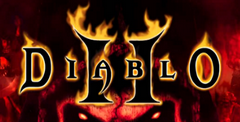
| a game by | Blizzard Entertainment |
| Genres: | Action, Adventure/RPG |
| Platform: | PC |
| Editor Rating: | 8/10, based on 3 reviews, 10 reviews are shown |
| User Rating: | 9.4/10 - 10 votes |
| Rate this game: | |
| See also: | Local Multiplayer Games, Diablo Series |
Overview
Everyone thought it was over. The Hero had descended into the depth and faced Diablo. The demon was gone and the pall of evil that shrouded Tristram had lifted. But Diablo was only contained -- not defeated. The Hero has now become the reincarnation of Diablo himself and is bent on freeing his two lesser brothers, Baal and Mephisto. Tristram lies in ruins and evil now walks the countryside laying waste to all in its path.
New Heroes must arise to fight... and you’ve chosen to join the fray. In your quest to push back the darkness and vanquish the demons that threaten to destroy the world, you will walk across vast plains crawling with undead and travel through dank caves reeking with the stink of unseen monsters. And you don’t have to fight alone, you can choose to fight alongside true allies, complementing and enhancing each other's abilities in order to create a force that must work together to succeed.
Gameplay, Controls, Interface
The gameplay in Diablo II is very similar to the original; fans of Diablo are going to feel at home almost immediately. Basic movement and attacks are virtually unchanged and while the graphics are greatly enhanced, they retain the flavor of the original game. Diablo II is split into four acts. The first act centers on an Amazon camp near Tristram (the town originally featured in Diablo). You even get to visit the now destroyed town on a mission to rescue one of the townsfolk. Other missions include recovering lost or stolen items from dungeons and crypts, finding arcane items and ingredients, and destroying the demonic minions that infest the land.
While the overall feel of the game is familiar there are several significant differences -- the two you‘ll notice first are the character classes and the way skill advancement works. There are five different character types in Diablo II: the Barbarian, Necromancer, Sorceress, Amazon, and Paladin. Each of the five classes has a skill tree of possible skills, no two of which are alike. The Paladins skills focus on Auras that either protect or enhance their abilities as well as their allies. Necromancers are masters of summoning, bringing fourth bands of undead warriors and golems to fight at their behest. The Sorceress uses the powers of magical fire, cold and electrical energies to unleash devastating spells. Barbarians and Amazons are master fighters, although they differ in their preferred choice of weaponry. Your character will gain new abilities each time he or she increases a level and also as a reward for some quests. Each skill point earned allows you to increase one area of expertise. The Sorceress’ skills are her spells -- no more hunting for a tome so you can learn a new spell, just spend the skill point and you’re there.
Another major difference is in the variety of items available and the all-new socketed items. Socketed items act like regular weapons, helms, and shields, but have one additional feature. During your adventures you will find gems of different quality levels that can be put into the sockets, granting the items new abilities. These gems can also change the look of the item when it’s equipped, making your character’s appearance in the game much more customizable than in the original Diablo. The game also includes new "set" items. Each piece of a set has enhancements and special powers, but when combined the entire set grants one or more additional bonuses.
Multiplayer
While the single player game is a lot of fun, Diablo II really shines in multiplayer. When players team together to fight, their powers augment each other. For example, the auras generated by Paladins apply to all members of the party, as well as any allies they’ve conjured or hired. Players aren’t automatically allied when they join the same game -- they must elect to team up. Since the maximum number of players that can join a game has been increased, it’s possible to have two or more parties in the same game. Blizzard has added other features to enhance multiplayer gaming, including a secure trading system that allows players to swap items and cash without risk.
There are two types of characters in the game: Open and Realm. Open characters are used in single player games, as well as LAN games, games hosted on private TCP/IP servers, and games hosted in the open section of Battle.net. These characters live on the player’s machine and are potentially open to being hacked or modified (in fact cheating is already becoming common in open Battle.net games).
Realm characters live on Battle.net and can’t be used in any games other than on the secured realm servers. Since they are stored on the servers they’re available from any machine (unlike the open characters) and they’re considered more secure. For most players realm games have quickly become the standard -- the extra security allows players to trust people they meet.
While the idea of the realm games is great, Blizzard has some serious problems when it comes to implementation. Battle.net’s realm servers have been consistently overloaded since the game’s release and in many cases have been completely down for hours or even days at a time. Blizzard is promising improvements and they can’t come fast enough to satisfy players who are becoming frustrated with not being able to play. The requirement that new accounts and characters spend at least two hours playing during the 48 hours after they have been created (or be automatically deleted) makes the inability to connect even more frustrating.
Graphics
The graphics engine in Diablo II is a significantly upgraded version of what was used in Diablo. Overall, the graphics are more detailed and the animations are smoother and more realistic. The nicest new features is the support for 3D accelerators for enhanced lighting and magic effects -- it’s really something to watch the shadows of barrels move as you maneuver around them in a dark dungeon. The 3D acceleration also adds extra perspective and depth to the graphics -- don’t get me wrong, the non-3D mode looks great, but the 3D mode looks amazing.
Be warned that there are some problems with the 3D modes though -- the initial release had problems supporting some cards and, while most of these have been fixed for Win 9x users, Windows 2000 users will still find many issues getting 3D acceleration working.
Audio
The soundtrack is wonderful and will even give you the chills at times. Each area of the game has its own background theme, which gets creepier and more foreboding as the game progresses. You can get a sample at Blizzards website -- they’ll be releasing MP3 versions of the soundtrack over the next few weeks. Topping off the soundtrack is a rich collection of effects and environmental sounds. There is little in gaming life more satisfying that listening to an enemy explode wetly after you’ve come very close to death yourself.
System Requirements
If you want to play multiplayer (and you do) the requirements are: Pentium 233 or faster (Pentium II recommended), 4X CD-ROM, 64MB RAM, 950 MB hard drive space available, and a 28.8k or faster modem.
Bottom Line
If you liked Diablo, you’ll like Diablo II. It’s proven very addicting and time consuming (just ask our wives), so if you don’t have much time, you may not be able to really enjoy it. We said this about Diablo but it’s just as true about the sequel: Diablo II really rocks. The gameplay has maintained all the features that made the original enjoyable and the enhancements to character growth, story depth, graphics, and multiplayer support are welcome improvements. While it is a great game, it doesn’t rate top honors due to the many issues with Battle.net and flaky support for Windows 2000.
Download Diablo II

System requirements:
- PC compatible
- Operating systems: Windows 10/Windows 8/Windows 7/2000/Vista/WinXP
Game Reviews
Bill Roper, one of the top men at Blizzard Entertainment, is an easily excitable man. Get him talking about his games -he's been responsible for groundbreaking titles such as WarCraft II, StarCraft and, of course, Diablo -his company or his attitude towards programming and pretty soon his chair's rocking back and forth like a grandmother on speed as he flows excitedly from one point to the next. "After we released Diablo we were deluged with letters saying things like, 'Wow, I really loved that game. It was great. Now here are all the things you need to do to make it better.' We really try to pay attention to that."
It's no secret that role-playing games have taken something of a downward turn recendy. The genre's flagship series, Origin's Ultima games, seemed to have stalled a few years previously and RPGs were suffering as a whole. Diablo's good-looking isometric graphics, action-orientated 'hack and slash' gameplay and typical RPG storyline (lone hero battles powerful demon to save the world) appealed therefore not only to hardcore role-players desperate for a fix, but also to a more general gaming audience.
Given its success (and the capitalistic nature of the industry), it was inevitable that we'd see a sequel. However, Roper insists that the decision to follow up the original was not simply down to monetary reasons. "After Diablo shipped and the team took a few weeks off, we started looking at what their next project would he," he says. Diablo was programmed by Blizzard North, one of the three separate programming teams at the company. "We had a few small technological ideas and internal development stuff, but they all just said, 'Look, we've talked about it and... we wanna do Diablo 2.' We totally understood that because we were the same when we did WarCraft. We kept saying, 'We wanna do WarCraft II because there was a lot of cool stuff we didn't get into WarCraft I really feel the same kind of leaps that were made from War I to War II are the same kind of leaps that they're making from Diablo 1 to Diablo 2
Leafs Such As...
At first glance, Diablo 2 looks more like Diablo 'Enhanced' than a fully-blown sequel. Which is understandable from one point of view - if it ain't broke, don't fix it.
The only trouble being that Diablo was broke, most notably on the multiplayer side of things. The infamous 'Diablo hack' almost ruined a perfectly acceptable alternative to Origin's Ultima On-line, the wood-chopping and sheep-farming simulation, by giving players the ability to alter their own statistics and equipment before they logged on. This time round Roper is adamant that having server-side information instead of storing everything on each player's machine (the root cause of the hacking problem), the on-line environment will be a definite improvement.
"We're going in a direction that gets rid of cheating, so we can have a persistent economy," he says. "We can prevent people from coming in and saying, 'Hey, I just made a bunch of these really great Swords of Damocles in memory, so here, let me pass them out.' We want to have things like incredibly rare items. Like if there were 250,000 people playing on Battle.net, there might only be five of that type of sword. You could go to a chat room on the Trading Post and say, Tve got a Sword of Damocles,' and people would go, 'Oh, I'll give you anything for it!"'
Roper is hoping that by having items that are not only rare but usable only by certain types of characters and that can combine with other rare objects, the on-line Diablo 2 world will take on a sort of organic nature. Quests will be initiated by players that have certain powerful items to trade for other, more useful, items. A wizard that finds - but can't use - a Shield of Arcane Defence, might use it as a reward for a warrior that brings him a rare piece of magic.
"Suddenly, still within the structure of how Diablo 2 works, but outside of the actual game, there are these new quests that are being given to all these players in multi-player mode, outside of anything that we could have put into the product," Roper explains. 'You already see that in other games, with bounty hunting and player killing and guilds and clans and so on. What we want to do with Diablo 2 is build up a lot more ways that things like that can happen: non-game specific quests. You have players who are saying, 'I know there's a set of these items, I read it on a newsgroup or in a magazine or someone came on the game and started talking about it.' And they start looking for it, talking to people, asking them about it. Stuff that generates naturally."
Beyond The Net
All of which is well and good for Nerheads, but it's the single-player market that makes up the majority of Diablo 2's potential audience. What's on offer for the non-wired fraternity? Quite a lot as it happens. First of all there's size. "We definitely wanted to make the world bigger. In the first game, even though you were battling to save the whole planet, it really felt like you were simply fighting Diablo just in this church in Tristam, purely because of the way things worked. Diablo 2 will have four acts, and each one will be in a different location." This allows one of the other weak areas of the first game to be resolved. 'Yeah, one of the things we definitely didn't do very well in Diablo was to communicate the storyline through the gameplay," admits Roper. "We've been focusing on integrating the storyline elements within the game. You never need to look at the manual because the entire story of Diablo 2 is presented through the character interaction. What will help us do that is to make the game about four times as big as Diablo. Each act is about the size of the entire first game and we wanted to be able to take you to a lot of different areas and interact with a lot of different people so chat the storyline could be driven from a lot of different angles."
There are other changes too. Day and night cycles enable the game to have monsters that react differently depending on the time of day, and magical effects that only work at specific times. Plots can also be driven by time, with certain actions only taking place when the moon is out, for instance. Mostly though, the cosmetic changes are little more than tweaks: line-of-sight vision and lighting effects add to the spooky atmosphere in darkened locations; the characters now move with pixel-perfect accuracy rather than being tile-based as before; you can now run around locations; a skill tree system enables you to customise your characters to greater degrees. 'Little' things like that. Where Diablo is really changing is behind the scenes. Artificial intelligence routines for the monsters combine with the object component systems to allow for greater variety in the enemy you face. "It won't be like in Diablo where if you ran into a horde of Horror Captains they would all have a shield and a sword," says Roper. "Here you might run into a horde of skeletons and they would have swords and shields and maces and clubs and spears. Who knows? The game will build the group of monsters on the fly,"
A Fine Line
Essentially Diablo 2 is building on die success of the first game without changing to the extent that it becomes unrecognisable. Roper is keen not to create something that feels 'nichey', a game that only appeals to the anorak brigade; "We want people to say, 'Well I've never really played an RPG, bu t this is a good kind of crossover.' I don't think it will turn off as many hardcore role-playing gamers as it will benefit the genre and bring in a lot of people who have never played an RPG before. The whole industry is helped by that. The more gamers out there, the better for all of us." Hail, arch-mage Roper. You are indeed most wise.
For a game so fundamentally simple, the original Diablo managed to generate an inordinate amount of interest from the hard-core role-playing fraternity. All the major forums and message boards were rammed with anal conversations about mythical objects buried deep within and meandering tales of personal adventures in the game. Strange for what was essentially a hack and slash 'em up... Whether this was because the game gave these usually intensely reclusive people the opportunity to drop their gaming guard for a little while by playing with their friends over the Internet, or simply suck in some honest to goodness eye candy, we'll never know. What we do know though, is that the sequel - yes, Diablo II - is almost certain to attract the same kind of games player as its predecessor, because essentially it's more of the same only better.
Wet Dream
Since we last saw the game, we've learned much more about Diablo II and what we can expect in terms of gaming enhancement. Because Blizzard have decided to keep the game 2D (with 3D colouring and light-sourcing), they are planning to avoid criticism of their technology by making everything else in it a role-playing gamer's wet dream, from the interface to the graphics, and everything in between.
We've mentioned before that the gameplay world of Diablo II will be split into four separate areas, or 'towns', each of which will have one main dungeon, several sub-dungeons and a surrounding wilderness area to explore. We've since learned that these towns are to be as big, if not bigger, than Tristram, the town from the original Diablo, making Diablo 2 more than four times bigger than the first game. So far, monastery, desert, and rainforest have been confirmed as towns, with one more town yet to be announced.
Go Quest
Once you've completed all the quests in one town, you will be able to return to it whenever you like, but you will not be allowed to move to another town until your business in the current one is finished. In total there will be at least 20 major quests in the game, all of which will be available in single and multiplayer modes. And, like the above mentioned restriction with the towns, you will only be able to move on to the next quest when you're finished with the one that you've got. Quests that we already know about include: Sister's Burial Ground (battle dead rogues in the Rogue Monastery Burial Grounds) , Field Of Stones (re-open an ancient teleportation system in the form of a circle of stones), The Forgotten Tower (clear out a beast-infested tower and search for treasure), Den Of Evil (rid a den of monsters and search for treasure), Tomb Of Tal Rasha (locate the Tomb Of Tal Rasha and prevent Diablo from freeing his brother, Baal). There will be new multiplayer options on Battle.net, including an online trading post and a player ranking system. Multiplayer games will enable up to eight players per game. Blizzard have also already hinted that they hope to release expansion packs that will add more quests to the game.
Skill Tree
There will be five all-new character classes with unique attributes and abilities (Amazon, Paladin, Necromancer, Barbarian and Sorceress), and 'Skill Trees' unique to each class have been developed to drip special powers and abilities to you as you progress through the story. The skill your character specialises in determines how you get to distribute level-up points. If you choose to go one way with attack skills, you'll be able to gain certain abilities, but others will be more difficult to obtain because of that decision. It will not be possible to learn each and every skill, so each character will be forced to specialise. Visually too, your on-screen fighters will be distinguishable - even down to the clothes and armour that they wear - thanks to some nifty built-in equipment/character modelling techniques. Pretty much everything your party wears and uses is shown on screen in minute detail.
Hey, Good Looking
Blizzard's art department have produced a great deal of significant work recently. Although a good proportion of it is still under wraps (we don't want to ruin it for you now, do we?), we've seen the real-time lighting effects bring to life some truly stunning 3D rendered bitmaps, making it more than easy to forget that Diablo II is not the polygonal wank-fest some of us were hoping for. Attention to detail is something that Blizzard have been renowned for in the past, and Diablo II promises to continue that trend. Atmospheric effects such as night and day cycles, rain and fog are in there, as are leaves blowing in the breeze, livestock moving from field to field, and rivers flowing in an eerily realistic manner.
A lot of the monsters too are not only better looking, but also bigger and badder. Take the Blunderbore, for example: a desert-faring beast with a tiny head and huge body. Or the Gargantuan Beast: a big, hairy monster which crushes opponents with its hands. And there's a boatload of other scary creatures. All have improved artificial intelligence, and some are now capable of working together and hunting in packs. As if it wasn't hard enough before...
No Bugs Please, We Re British
In the end there's no doubting Diablo IPs potential. As long as we don't end up with a buggy first release, Diablo II could well end up being one of the slickest games ever made. Even the menus look sexy, sleek and superbly designed. Blizzard know what they've got, know the people who want it, and arc promising to deliver early next year. And, providing we're not eating our words thanks to 'slippage' come next November, will be the first to playtest it for you. Watch out for a full review and a final verdict soon.
That All-Important Storyline
In a nutshell, here's what Diablo 2 is all about... As the game opens, the hero (after containing Diablo's spirit in the first game) journeys to the East and assumes Diablo's original appearance and power. He then marches oft to raise an army to aid him in his conquest of the world. Diablo's plans unveil as the game progresses: he's attempting to free his brothers, Baal (the Lord of Destruction) and Mephisto (the Lord of Hatred), in order to reinstate the triumvirate of evil. What this means in gaming terms is that you're in deep trouble and must hack up loads of monsters to prevent the bad guys from winning.
The original Diablo was a phenomenal success. The graphics were simple, the gameplay was even simpler and the story was virtually nonexistent. But somehow, thanks to the delicately balanced difficulty level in the single-player game and the immense popularity of the multiplayer aspect with the hardcore online community, Diablo was a winner. With such a big audience waiting to eat it up, there's no denying that this sequel will be another success. But it won't necessarily be winning any fans among the critics of the original.
Devilishly Average Looks
If you're not expecting much more than Diablo 1.5 you won't be disappointed. Blizzard knows exactly what its fans want: the same, only much more of it. This would be fine if the sequel had been released two or three years ago but, viewed now, Diablo II looks positively lame. Graphically there's only minimal improvement. The resolution is tirmly stuck in a 640x480 sprite time warp and the animation is jerky and clumsy. In fact, it doesn't look any better than, say, Fallout 2, another isometric RPG released a couple of years ago. Alright, so it's brighter and more colourful and it uses your 3D card to make some of the spells slightly spectacular. So some of the monsters are a lot bigger than before and you can have more of them on-screen. So what? But then Blizzard has never dazzled us in the graphics area. Nor has it had to. WarCraft was an incredibly successful RTS, but nothing special to look at. One of the reasons is that its games are only very secondarily single-player experiences. Undemanding graphics mean that online play is always smooth, which it's why it's mostly American players who lap its games up. But that's no excuse for letting Diablo II look like such a complete dog. Core Design keep flogging us the same game, but at least every instalment of Tomb Raider looks much better than the previous one. And some of the biggest online games, Allegiance and EverQuest for instance, show that you can still have great graphics and play smoothly over the Net. Still, the old adage goes that it's gameplay and not graphics that counts.
Hit, Maim, Skill
While Diablo II is still a simple game - involving not much more than straightforward sword-hacking and spell-casting - it is definitely more complex than the first one. There are improvements that were blindingly obvious necessities, such as the ability to run or being able to keep the mouse button pressed for continuous movement, rather than constantly pointing and clicking. There is a stamina bar that decreases rapidly as you run to stop you from constant flight. This is a combat game after all. The interface works well.
Here, once again, simplicity is the key and there's no reason to mess about with a tried and tested format that people feel extremely comfortable using.
The main improvements are the number of character classes now available (Necromancer, Paladin, Amazon, Barbarian and Sorceress) and the branching skill trees each of them has. As you gain experience points you can choose to spend them building up your stats or acquiring new special abilities and powering them up.
Traditionally, only spell-casting characters have had this element of skill exploration, with mages discovering all sorts of new spells and warriors condemned to ham up their strength and dexterity. In Diablo 2, all the characters have skills they can acquire and explore, making experience point-spending a much more interesting facet.
Another way of spending your money is hiring team-mates at towns to fight alongside you. You'll normally find a rogue or mercenary boss who sells you one of his warriors in much the same way that the blacksmith sells you his weapons. Each warrior has their own attributes, so the more money you spend, the better a fighter you'll get. You can only have one of these oafs with you at any one time, although they will fight till the bitter end. As you'd expect, they're not known for their intelligence and will be content to throw themselves with wild abandon against any enemy that comes into sight. At least they're better than the sidekicks in Daikatana.
Little And Urge
Each portion of dungeon is tiny compared to the sprawling levels found in the original. You are led down restrictive corridors much more and there is hardly any real exploration involved. On the other hand, the outdoor levels are wildly open and can leave you wandering around for ages before you find what you're looking for. There is a wider variety of styles compared to the first game, with Egyptian backgrounds competing with the more common grey dungeons and castles, but the random plan creation clearly limits the quality of design. The randomness adds a lot to the replayability value, but do you really need it? After all, the game is absolutely massive, requiring an insane amount of hours to complete. And, if you want to try out all the classes, the time is multiplied. So why choose random, simplistic and almost empty maps instead of specifically created ones, apart maybe from the advantage of more unpredictable multiplayer games? Not only are the dungeons created randomly, so are the towns and forests, so you can be sure to be stepping into, if not a completely different wortd, at least a less predictable environment. Diablo II really is truly huge. Unlike its sprite-driven graphics, it is a game of monstrous proportions, easily three times bigger than the original. There are four towns which the quests are launched from (divided into three acts) and plenty of roaming wilderness, as well as the unavoidable dungeons.
For such a plain-looking game, though, there's not an awful lot of interaction with the precious little environment to be found. The Ultima series at its height always created simple but loglstically real worlds to explore. Diablo seems bent on its one-dimensionality. The legions of fans demand little more than straightforward hack and slash, and Blizzard certainly hasn't gone out of its way to provide much else.
Kill By Numbers
One of the biggest attractions of Diablo has always been the anal obsession with character building, maxing out all your stats, levelling up, getting more money and buying better weapons and armour. We could go off on a tangent about this numerical fixation being a metaphor for consumerist society, but we won't. There is, however, little doubt that the single-player game would have been left largely untouched by the hardcore Diablettes had you not been able to transport your character from your solo game to the multiplayer arena. In the same way that the ancient Gauntlet (of which this is a direct successor) was OK on your own but an absolute classic when your friends joined in, Diablo really comes into its own online. We'll be reviewing the multiplayer side of it in our Online section in the very near future, when the community really kicks off. Blizzard is sure to address many of the problems people found first time round, not least of which was the rife cheating, where players would bump up their statistics into stratospheric numbers and proceed to murder any other player that should cross their path.
Positively Evil
Despite all the criticisms, if Diablo 2 is essentially the same game with knobs on, it can't be all that bad. And it isn't. The gameplay is just as undemandingly addictive as ever, you can still choose the level of difficulty that suits you, and there's still a strange satisfaction to be had from levelling up and bringing down a large creature with a stroke of lightning or a mighty swing of the axe.
But, for all that this sequel has added, there is still something sorely missing. It has no sense of atmosphere and feels more like a heartless expansion pack. I remember playing Diablo and reaching one of the first bosses, a mad demonic butcher, with arms as wide as cows and a disturbing aura of evil. I sauntered wildly through the dark dungeon, my racing heart willing my character to move faster, chased by this maniac and stumbling across horribly mutilated corpses broken in a puddle of blood you could almost smell. There is nothing like this here. Even when you see bodies impaled in a macabre landscape, you feel no quickening of the pulse, no terrified awe, you just click on them to see if there's any money hidden in them. You find hideously powerful creatures later in the game, but none have the presence to really scare you.
No doubt all you true Diablo heads out there will violently disagree with me and demand my head on a stake, but you will have already bought the game and played it to death anyway without the need of any vindication from our pages.
We're sure you'll enjoy it immensely. The rest of us, however, will turn our thoughts to a world of ever-progressing, ever-deepening, ever-evolving computer games. Vampire may be done and dusted, but there is the sheer majesty of the crowning masterpiece of role-playing, Deus Ex, to look forward to now.
You Can't Buy Class
It may not seem like too big a deal, but the jump from three character classes to five is made all the more important by the subtle effects on gameplay each of them has. Many of the differences are merely in the head of the player because there's not much variety in the way the game progresses by chomping through legions of monsters with swords or spell-cast snowballs. But there's enough to make you want to try out every character, and to level at least a couple of them up enough to see what they can really do.
Five Go Down A Dungeon
Amazon
Somehow this lucky jungle woman has kept both her breasts intact, which makes it hard to see how she can be so accurate with her bow and arrow. Of course, their mono-breastedness is far from being a proven historical fact, but there is definitely a distinct lack of horse riding bow-leggedness, or indeed of any horses. What you will get with the Amazon is great skill with the spear and arrows. The obvious advantage over a Barbarian or a Paladin is that you can conduct ranged attacks, thus keeping harmful creatures at bay long enough to split their heads open. You'll need more than a sharp and thin piece of wood to get rid of the bigger enemies. Or when you're facing a screen full of smaller ones, which is why you can acquire your own special abilities, you can turn your arrows into incredibly powerful magical weapons. You can also summon a muscular Valkyrie to fight with you.
Necromancer
If the Valkyrie is not entirely to your liking, perhaps too lively and healthy-looking, then the powers of this corpse-lover may be more up your dark and twisted alley. The macabre Necromancer is rarely alone and is capable of summoning skeletons and golems from the fallen bodies of slain monsters. This is unquestionably the character to play if you want to give the game the sinister edge it lacks, but it's still not as darkly evil as we'd like it to be. Raising skeletons loses its charm after a while, but there are other spells like the one making corpses explode in the face of your enemies, or the one that traps them in a bone prison.
Barbarian
No RPG is complete without one of these muscly, brainless and unexciting characters. In Diablo II be comes in the bald and ethnic variety rather than the dark and hairy Conan-clone shape. He's also capable of carrying weapons in both hands, turning him into a real meat-grinder. If you thought the lawnmower at the end of Peter Jackson's Brain Dead was an effective weapon, wait till you see the Barbarian's double-hatchet wrist action. To make the character more interesting he also has his very own special skills tree. Since he's so much of an animal that he can't articulate words properly, most of these skills are in the form of battle-cries and work in a similar way to spells. You can use them to strike terror into the heart of enemy creatures or make you momentarily stronger. There are other skills, such as the useful but hilarious Leap Attack, where he prances about like a ballet dancer, or the whirlwind one, where he turns into a deadly Warner Bros Tasmanian Devil, whizzing around the screen.
Sorceress
As with most RPGs, the truly magical character is the weakest to begin with but by far the strongest once you have enough experience. There is a large contingency of fans whose sole purpose in life is to cast more and more powerful spells and who are only fulfilled when the palms of their hands are crackling with a freshly cast electric bolt. If you're one of them, then the Sorceress will be your character of choice. Her skill tree is the most rewarding and, when you reach the higher echelons, there is very little that can stand in your way. The downside is that her spells are the most familiar and least original, with the usual fare of firewalls, lightning bolts and meteor storms. You do get to summon a hydra to fight with you though.
Paladin
The Paladin is a righteous but fascinating figure, combining the faith of a monk, the honour of a samurai and a shiny silver armour suit. Apart from the usual fighting skills you can work up, you can create mystical hammers to spiral around (handy to knock skeletons into a big pile of bones) and heavenly shields to protect you. The most interesting concept, though, is the one of auras. There are defensive and offensive ones, and they work pretty much the same as curses or spells, with the most effective being the religious ones like Fanaticism and Meditation. Not that we condone the narrow-mindedness of fanatics, whether it's for religion or for Diablo...
Two years to make a game that only runs at 640x480 resolution and requires a microscope to see any difference from the original. Two years to build a chat/game interface that is worse than the original and two years to dream up the brilliant idea of having the patch server on the same box as the game server... duh!
Beneath the surface Diablo II is a much-enhanced game - the addition of server-based characters, increasing the maximum number of players per game, expanding the playing area, adding the 'hardcore' game (albeit a blatant rip from the 'ironman' game created by gamers for the original Diablo) and lots more. Also, let's not miss the fact that the game now reacts to increasing numbers within a game, more players more baddies - simple but a nice touch - the ability to form a proper gaming party and, of course, the player 'stash' in which to store goodies for trade.
As far as gameplay is concerned, it's the pure hack 'n' slash dungeon-romp that we all know and loved. As an RPG Diablo His less impressive, the AI is even more simplistic than its predecessor, with baddies resorting to overwhelming you in large numbers. But, we have to face facts, this isn't a cerebral game - it never was.
WORTH THE WAIT?
As a 'pure' RPG Diablo II can't quite hack it. As an action RPG however, it fares much better.
But as a multiplayer game, Diablo II borders on farcical. Why? Because the servers that are available simply can't cope with the demand. Sure I can play 'open games', where I use my single-player character, but I've been doing that for years - in a game called Diablo.
Diablo 2 was supposed to be about playing the game in its entirety with your mates (or enemies) and, until Blizzard sorts out its servers, this is simply too much of a chore. But what really sucks is if, and when, you do get into a game, Diablo II really isn't that bad. After the wait, though, all you get is a numb ass, a full bladder and your ashtray looks like Mt Etna - six hours go by, it's 3am and you're thinking about skiving oft work.
The point is that at the moment it's not worth buying Diablo 2 to play online. If you do you'll only end up frustrated and bitter (as I did) and you'll never play it again. Best thing you can do is wait until Blizzard sort their servers out. There are better things to do than sit staring at your monitor until 4am.
Other frustrations such as latency, not being able to create games, not seeing games (the list goes on and on) can all be traced back to the servers again! Though it quashed a few minor bugs, the recent patch added a countdown to game creation - so now you can sit for 20 minutes watching a counter go from 999 to 0 and then get a server error. What's the point?
What we said
"Despite all the criticisms, if Diablo 2 is essentially the same game with knobs on, it can't be all that bad - and It isn't The gameplay is still as undemandingly addictive as ever. But, for all that this sequel has added, there is still something sorely missing. It has no sense of atmosphere and feels more like a heartless expansion pack."
What you said
People say:
- "I've always considered PC reviews to be well balanced because they always weigh up the good and bad points of a game. But, unfortunately, your review of Diablo 2 was not up to scratch. Your main focus of attack were the graphics. I mean, come on, what were you expecting? Also, there was no mention of the great light sourcing which causes moving shadows. I distinctly remember walking into some of the tombs and being impressed by the moving shadows. I teel that you have let yourselves down by printing a review, which is simply pants. And 72 per cent? I really think it deserves better."
- "I can't believe what you said about Diablo II. You say the game isn't innovative. That might be true, but look at what you gave C&C: Tiberian Sun, the biggest pile of crap Westwood's ever produced. If you gave that 82 per cent, then surely Diablo 2 should have got at least 80 per cent. In fact, your whole review was suspect, you make a huge fuss about the graphics being rubbish, after previously remarking that it's the gameplay that counts and not graphics. It's more than a little schizophrenic. Oh well, that's what you get if you let a man who doesn't know which part of his body he would enhance review a great game like this. Although it might only be a start, enhancing his brain might just give him some insight and intelligence.
Comment
Well you're entitled to your opinion and if sale's figures are anything to go by you're in good company. We know there are people out there who swear by Diablo II - over a million people can't be wrong. But our score reflects a pretty united front in the office. We don't think it's enough to release what's essentially an add-on pack and proclaim H as a fullblown sequel. If you're honest you'll agree that the graphics are pretty poor and, as gamers who pay hundreds of pounds for new 3D cards, we have every right to demand top quality visuals as well as excellent gameplay. We never said Diablo //is rubbish, and under our new scoring system 72 per cent is a respectable score.
Strategy Guide & Walkthrough - Part Two
In this strategy guide we tell you the quickest way to progress through each quest, as well as a list of the major monsters you will face on the way. We also include a detailed look at each character class and the special moves and spells associated with them. To polish things off there's a quick guide to the items you can find in the game and that cheat So, let's get on with it...
ACT III: THE INFERNAL GATE
Kurast Docks is the home of these helpful characters:
Alkor Potions for sale.
Asheara Offers the help of level 15-26 mages for between 600-1285 gold.
Deckard Cain The omnipresent Cain identifies your magic items. Hralti Mas a plentiful supply of armour and weapons. Also good for repairs.
Ormus As well as offering health potions, Ormus restores your health and mana.
Meshif Takes you back west. Natalya Strange old woman with the odd bit of gossip.
Quest 1: The Golden Bird
As soon as you venture out of the safety of the town, the first unique monster you kill drops a Jade Figurine. Take it back to Meshif and he gives you the Golden Bird. Wander over to Alkor and give the Golden Bird to him. Now return to Meshif for an excellent potion that increases your life points by 20. That's it - the first quest is complete. See, things aren't so bad here, are they?
Quest 2: Blade Of The Old Religion
As you venture through the extremely tricky Flayer Jungle you come across a Pygmy village. Within this village there is a Pygmy Shaman who holds the Gidbinn Dagger. Kill him to get the dagger and then take it back to Ormus at Kurast Docks. He rewards you with a randomly generated Magic Ring. You can now visit Asheara who offers the services of her mercenaries. Generally speaking, it's the mages with cold spells that are the most effective; their ability to freeze enemies is invaluable at this point in the game.
Quest 3: Khalims Will
After completing Quest 2, talk to Cain to get the details for Quest 3.
You can find Khalim's Eye in the Spider Cavern in the Spider Forest.
Make sure you have resistance to fire before you go after it though, because SszarkThe Burning can be very hot to handle.
Khalim's Brain is guarded by Witch Doctor Endugu on the third level of the Flayer Dungeon.
He shouldn't put up much of a fight providing you go in hard and fast. The third body part, the Heart, can be found in the sewers on level two. The Flail is in Travincal, but beware, it is extremely difficult to get hold of. Ismail Vilehand is the Council Member you need to beat, and the best way to do this is tempt him out into the open and get your hired mage to blast him with cold spells. Once you've got the Flail put it in the Horadric Cube with all the body parts and transmute the contents into Khalim's Will.
Quest 4: Lam Esen's Tome
Talk to Alkor to find out details of this quest. Go through Upper Kurast, the Bazaar and the Causeway. The Ruined Temple is found by clicking on a set of steps leading down. The only way to find the steps is by experimenting.
Once inside the Temple you need to kill Battlemaid Sarina to get the Tome. As long as you keep topping up on potions during the bout you shouldn't really have too many problems with her. With the Tome in your inventory head back to Alkor for a reward of five extra attribute points.
It's worth mentioning that you don't actually have to complete this quest to continue, but hey, five extra attribute points shouldn't be sniffed at.
Quest 5: The Blackened Temple
This is probably one of the most straightforward quests - you can't go wrong really. Once you've created Khalim's Will, return to Travincal and kill the rest of the Council Members. Once done, smash the Compelling Orb with Khalim's Will to reveal the stairway to the Durance of Hate. Before going down, return to Ormus and Cain for some words of advice.
Quest 6: The Guardian
Wander down into the Durance of Hate. Edge your way through carefully. Try and find the waypoint on level two because chances are you'll be using it regularly. Before you reach Mephisto on level three, you'll be assaulted by dozens of Blood Lords and Council Members. Take it slowly - they're deadly.
Once again, we cannot emphasize enough the importance of a cold spell-wielding mage at this point. Resistance to fire also helps. When you finally reach Mephisto he is surprisingly easy to defeat; most characters can rush in and hammer him to death at close quarters. After his spectacular death he drops his Soulstone and a unique or rare magical item.
And that's it for Act III. All you need to do now is go through the red portal and enter the final harrowing act...
Act Iv: The Harrowing
There are only a few friendly NPCs in the Pandemonium Fortress:
Deckard Cain Is there no stopping this man?
Halbu Your handy weapon and armour selling chap.
Jamella Scrolls, potions, weapons, armour... you name it-she's got it.
Tyrael Reckons he can offer you advice. In fact, he's full of it...
Quest 1: The Fallen Angel
When you first arrive in the fortress, have a chat with Tyrael. He'll tell you the terribly sad story of Izual, and how he needs to be free from his torment. Fine. Head into the Plains of Despair and find Izual on his lonely patrol. Use ranged attacks to kill him and providing you remain patient, he shouldn't be too difficult to defeat. When you kill him you get two extra skill points to play around with. Nice.
Quest 2: The Hellforge
The Hellforge is in the River of Flame, which can be found near the bottom of the staircase that leads out of the City of the Damned. To get the Hellforge Hammer kill Hephasto. When you have the hammer, equip it and click on the forge to smash Mephisto's Soulstone. You get loads of lovely gems for doing this, so if you want to make a useful socketed item, now is the time to do it Our advice is to create something that gives fire protection, or something that inflicts cold damage.
Speak with Tyrael for some final words of advice on how to deal with Mr Diablo himself.
Quest 3: Terror's End
Go back to the River of Flame and hack your way through to the final waypoint. Keep going and when you get to the Chaos Sanctuary don't be scared of retreating when you are faced with hordes of enemies. Ultimately you need to open the five seals to make him appear, unfortunately three of the five seals contain unique monsters, namely the Grand Vizier of Chaos, Lord De Seis and the Infector of Souls. Diablo himself is like nothing you've ever seen and the strategy for defeating him depends a lot on which character you are. However, it goes without saying that no matter who you are, you should be topped up with health, mana and rejuvenation potions.
More specifically, those playing as the Sorceress should have the easiest time of it. She can destroy Diablo fairly quickly providing she has the right skills. By far the best combination is to use the Meteor skill plus Static Field to reduce Diablo's health by a third each time the Meteor strikes.
Amazons should also find things relatively straightforward. Go for the old hit-and-run tactic with Impale and use the Decoy skill to confuse him. The Valkyrie spell A comes in useful too.
Paladins can use the Thorns skill so that each time Diablo hits, the damage is bounced back to him. This doesn't work for all attacks though, so make sure you still avoid his magic ranged attacks.
Barbarians of course should stand toe to toe and duke it out The only time the Barbarian needs to take cover is during the Lightning Inferno.
And finally we come to the Necromancer. Ideally he should attack with Poison or Bone spells while a summoned Golem keeps him occupied.
Now, don't think you're going to kill him first time. This part of the game does take practice, but providing you stick with what we've told you, you should be OK. And that's about it - good luck.
Who Wants To Live Forever?
If you don't already know this cheat, It's a miracle you've got this far. Anyway, for those remaining honest few, here you go. When you die press 'Esc' to restart, and then press 'Esc' again, save the game and exit Load that character again and your old corpse reappears on the floor in front of you with all the stuff you were carrying. Now, just left-click on your corpse to re-equip. Sadly, any gold you collected will still be gone, but hey, you can't have everything.
Character Spells And Abilities
As in all areas of life the answer is to choose wisely...
Now, the character you choose to play the game as pretty much dictates your whole Diablo 2 experience There are also many character defining attributes to think about once you've picked your character. One of the most important decisions you need to make is what skills your character should excel in.
Generally speaking it's best not to spread the skills too much. Concentrate instead on three or four areas and strive only to improve them. Take the Amazon for example: instead of having many weak areas she should have one strong bow skill, one strong javelin and spear skill, and one strong passive skill. This way she will always have something she can trust and rely on. In the long run this tactic is far more reliable than being 'jack of all trades, but master of none'. There follows a list of every skill in the entire game and what they do. Use this information wisely, it might just win you the game.
AMAZON
The Amazon is an all-round character. She is great with ranged weapons such as javelins and bows, and equally as deadly up close with spear type weapons. Dexterity and strength are her main attributes.
BARBARIAN
The Barbarian is a master of hand-to-hand combat He is unsurpassed in skill with swords and axes. His main strengths are his vitality and his immense brawn.
NECROMANCER
You could say the Necromancer is the ultimate coward. He specialises in raising an army of the dead and getting them to fight his battles for him. Energy and dexterity are the Necro's most important attributes.
PALADIN
The Paladin is a great fighter as well as an unselfish team player. His vast selection of auras can help allies to fight better and weaken monsters. Strength and energy are his most Important assets.
SORCERESS
The Sorceress rarely wades in for a brawl, preferring instead to stand back and use her spells. At higher levels, her fire, lightning and cold spells are very effective and arguably make her the most powerful character. Energy and dexterity are her strengths.
Strategy Guide & Walkthrough Part One
This month we offer a walkthrough for the first two acts of the game, as well as a wealth of information on the types of monsters you'll face during those initial levels. We've also included a recipe list for the Horadric Cube. Hopefully that should keep you busy until next month. If it doesn't - tough; it's all you're getting for now...
Act I: The Sightless Eye
In the Rogues' Camp make use of the following characters:
Akara Heals health and mana. Also sells magic paraphernalia.
Charsi Trades and repairs weapons.
Deckard Cain Identifies items for free once you've rescued him. Gheed Bit of an all-round trader, but don't fall for his gambling ruse.
Kasha Hires out warriors for 150-490 gold pieces after you have completed quest two.
Warriv The caravan driver gives you a ride east once you've completed Act 1.
Quest 1: Den Of Evil
To receive your first quest, talk to Akara. Go to the cave on Blood Moor and kill every monster in there, including the unique zombie called Corpse Fire. Providing you have plenty of potions he won't be a problem. When the sun lights up the cave, return to Akara in the camp.
Quest 2: Sisters' Burial Grounds
Talk to Kasha to find out about his quest. To reach the Monastery Graveyard you need lo go through the Cold Plains. Some of the monsters can be quite nasty in that area, so again, top up on health potions.
When you reach the cemetery on the far side of the Cold Plains, kill the undead zombies and stuff wandering around near the perimeter first. Once you've thinned them out a bit, head towards Blood Raven in the centre. Barbarians and Paladins can go straight for the jugular and take her on face-to-face by pinning her in a corner. Other characters can only really beat her by using long-range attacks while avoiding her flaming arrows.
When she's dead you have two choices: you can go back to camp for the next quest, or you can venture into the Crypt and Mausoleum to gain some extra experience and treasure. The latter is recommended.
Quest 3: The Cairn Stones
Talk to Akara for this difficult quest. Go into the Cold Plains and go all the way through to the entrance of Stony Field; in the Stony Field there is a passageway to the Dark Wood; in Dark Wood go right to the Tree of Inifuss. Kill Treehead Woodfist and then left-click on the tree to get the scroll. Mead all the way back to Akara for a translation.
With the translation complete go back to the Cairn Stones in the Stony Field and kill Rakanishu who guards them. Touch the stones in the order shown on the scroll and you are teleported to Tristram. Head for Griswold and kill him with a ranged weapon. Release Deckard Cain from his cage, and then return to camp.
Quest 4: The Forgotten Tower
To activate this quest, touch the mouldy tome in the Stony Field. When you've done that go through the Dark Wood to the Black Marsh and find a ruined tower. In here there are five levels of pretty intense fighting. There is also at least one random unique monster or group of champions on each level. It's not easy, but on the plus side there's loads of treasure.
On the bottom dungeon you find the Countess and her minions. She's a fiery character to say the least, so make sure you're equipped with some kind of item that offers good fire protection. After you've killed her little entourage, attack her one-to-one. When she's dead collect all the gold and go back to the camp to talk to Charsi.
Quest 5: Tools Of The Trade
Charsi has managed to lose her hammer in a nearby Monastery. Walk from the Dark Wood, to the Black Marsh, and then to the Tamoe Highlands to find the monastery on the far right of the map. Enter the Outer Cloister and be sure to activate the waypoint -you're going to need it.
After gradually heading down through Cloisters and into the jail you meet The Smith. This guy is a unique monster with immense strength. Providing you avoid his stupendous hammer blows, he's fairly easy to beat, though. Once he's worm food, collect the hammer and go back to Charsi who offers to imbue one of your items with magical powers.
Quest 6: Sisters To The Slaughter
When the five other quests have been completed talk to Deckard Cain. Go to the Catacombs that can be found in the Monastery Barracks near where you killed The Smith. Andariel is on the fourth level of the catacombs. If you want to stand any chance of beating her, make sure you are at least level 14 before taking her on.
To defeat her use resist poison to nullify her poison attacks. On top of that you should always keep moving; run in and attack, then run away again. Repeat this over and over again until she explodes. Return to the camp, talk to Warriv and head east...
Act 2: The Secret Of The Vizjerei
Quest 1: Radamerrt's Lair
There are two entrances to the sewers - go through whichever one you prefer. After forcing your way down through four levels you finally discover Radament. This can be one hell of a fight, especially if you don't dispose of his meandering minions before taking on the man himself. The battle is extra difficult due to Radament's immunity to nearly all forms of magic, so getting up close is easily the best way to dispose of him.
After you've killed him, pick up the Horadric Scroll and Book of Skill and return to Cain.
Quest 2: The Horadric Staff
Speak with Atma for the low-down on the next quest. To reach the Horadric Cube you need to go to the Dry Hills and enter The Halls of the Dead. On the third level a unique Sabre Cat must be killed to get the cube. Once you've got that, it's off to find the Horadric Shaft in the Sand Maggot Lair in the Far Oasis. Cold Worm the Devourer guards it. He relies on his hordes of squishy minions to stop you getting near, so use a ranged weapon to get rid of them all and collect the shaft. The final part of the Horadric Shaft is on level two of the Claw Viper Temple, which can be found in the Valley of the Snakes past the Lost City. The main enemy in there is Fang Skin; a quicker version of the snakes you've already come across. Defeating this manic reptile shouldn't be difficult providing you have good armour and lots of health potions. Finally, when you have all three parts of the Horadric thingy, go back to Cain in Lut Gholein and listen to his musings.
Quest 3: Tainted Sun
This quest is actually completed after you get the part of the Horadric Shaft that restores the sun.
Quest 4: The Arcane Sanctuary
Talk to Drognan and enter the Palace. Things get very interesting now. Inside you need to navigate your way through two levels of Harem and three levels of the Palace Cellar to find the entrance to the Arcane Sanctuary. It's a tough fight to get through, but just take it slowly and keep topping up on potions by teleporting to town as much as possible. Destroy Fire Eye, a unique Sand Raider, and then step through into the Arcane Sanctuary to complete the quest.
Quest 5: The Summoner
Meticulously work your way along the weird and wonderful Arcane Sanctuary until you meet the Summoner. At this point it's imperative to have some kind of cold resistant item to protect you from the Summoner's deadly ice blast. To kill him try ranged weapons for pretty much everyone apart from the Barbarian; his knockback skill seems to work wonders here. When you've killed him a portal appears - step through this to reach the Canyon of the Magi.
Quest 6: The Seven Tombs
As soon as you arrive in the canyon touch the waypoint marker in order to quickly get back here when you die - and believe us, you will die. Find the true Tomb of Tal Rasha by matching the symbols on the tomb entrances. Go down into the chamber and insert the Horadric Staff into the Horadric Orifice to blow open a hole in the wall. Step into that hole to reach the demon, Duriel.
Killing Duriel is extremely difficult. Dodge his cold blasts and keep your distance as much as possible. Again, ranged attacks are the best strategy, although because he has so many hit points, it takes a hell of a long time. Providing you remain patient and get into some kind of rhythm, he eventually dies. Release the friendly(?) demon Tyrael and go through the portal.
Prepare to face the Lord of Terror once again in the sequel to last year's smash action/RPG hit. This time around, you'll have five character classes to choose from, including the paladin, the necromancer, and the amazon, each with their own unique attacks, skills, and spells. Four towns, plus outdoor areas, will be yours to explore. Blizzard has even tweaked the battle.net support, adding player rankings and an online trading post so players can swap items. This one looks hot.
Diablo's back-and he's not happy! The Lord of Darkness returns to enslave humanity in Blizzard's hot action/RPG sequel.
Second Hell-ping
Because the original Diablo--a graphically rich, extremely addictive hybrid of hack-and-slash action and fantasy RPG elements--was such a massive hit, Blizzard (the game's developers) won't be meddling with the formula too much for the sequel. Many of Diablo M's expected changes are refinements, tweaks, and expansions of previously good ideas. Watch for a tighter interface, "stackable" items (such as storing scrolls in books), buildings you can enter, items that look the same in hand as they do in your inventory, a banking system, and other new stuff.
The addition of 3Dfx graphics might seem foolhardy in a 2D game, but they offer cool global lighting effects, a wheel-mouse zoom function, and improved overall speed on low-end systems. Of course. the added graphical kick will also enhance the game's awesome spells, like ice storms, corpse explosions, poison novas, and blaze--a fire-wall that trails behind you.
An eternal wait
Gamers received their first sneak peek of Diablo II at E3. Although this crop of images looks great, don't get too frothy--the game is slated for a very loose six-month release window.
The demo we saw contained four of the five characters as graphically complete, and some 200 monsters and characters were already implemented (Blizzard predicted it would have every last demon in place by the end of '98). Unfortunately, the voices had yet to be recorded and more than half the world was left to build. As long as Blizzard takes the time and makes Diablo II worth the wait, fans won't mind sticking around to play the final product.
Party people
Diablo II contains five character classes, and each character can develop up to 30 specific skills and various spells, decreasing the chances of redundant characters in your battle.net party. For instance, amazons can use both bows and javelins, though you'll probably want to concentrate on one or the other.
Players can travel through four towns, including deserts and rain forests, that are packed with new random dungeons. To round out Diablo II's features, characters can now run as well as walk, and multiplayer games will accommodate up to eight players.

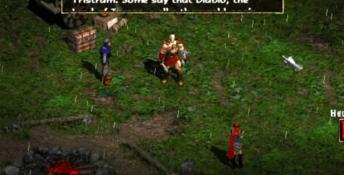
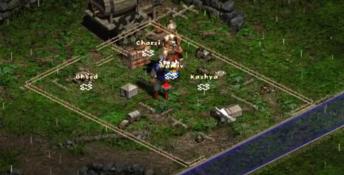
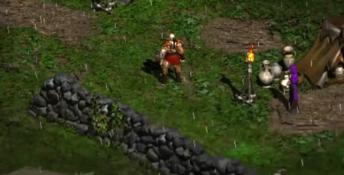
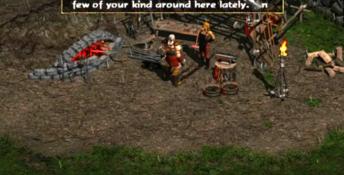
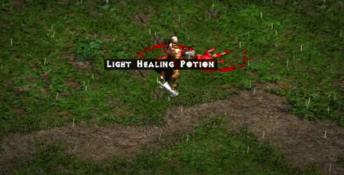
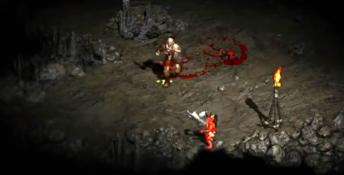
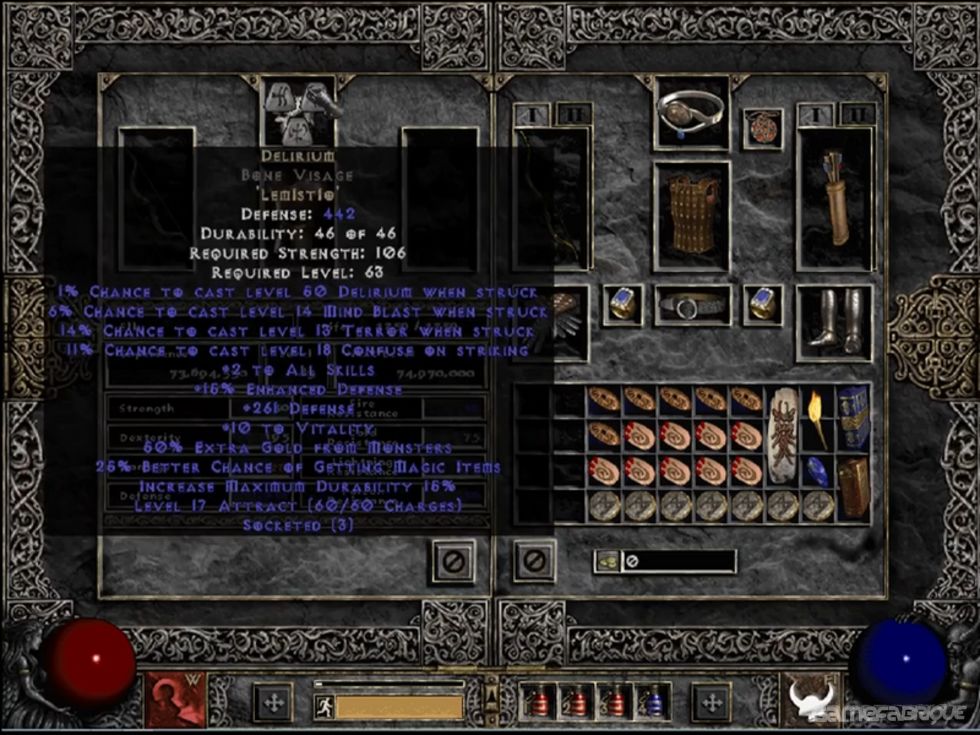

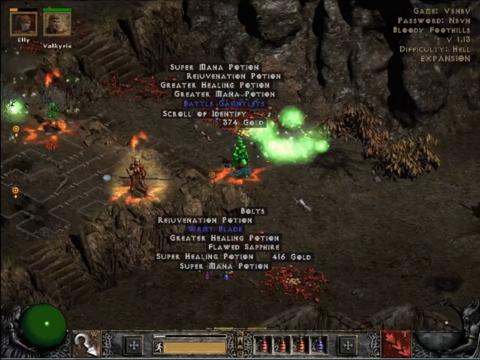
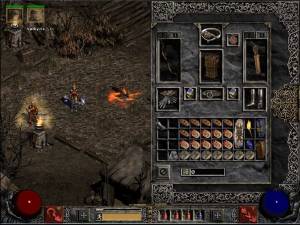
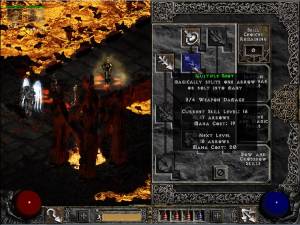


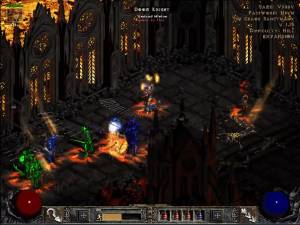
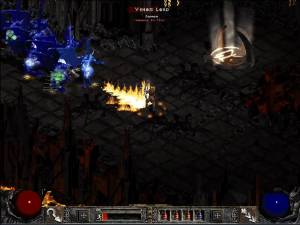



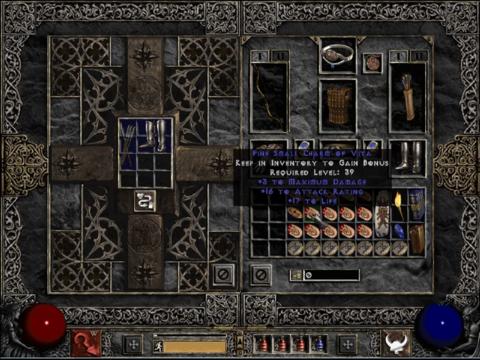
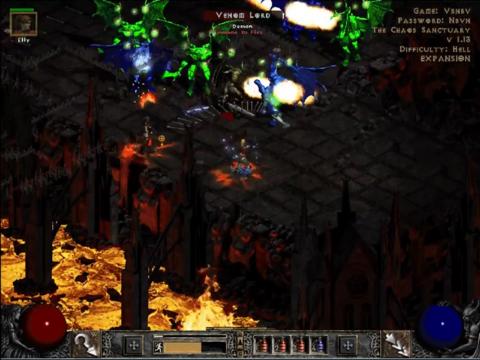

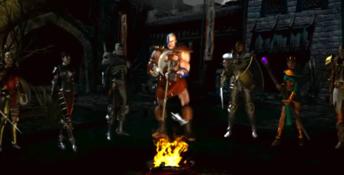

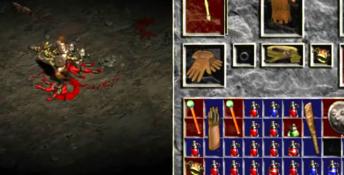
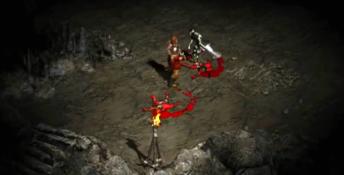
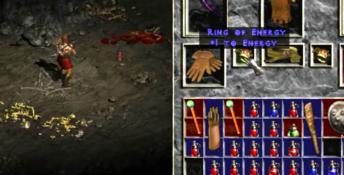
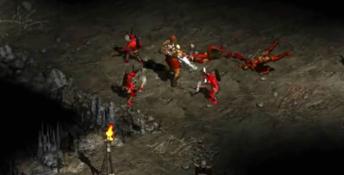

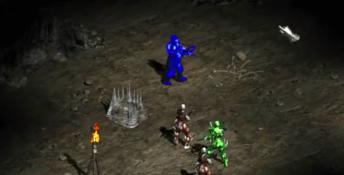
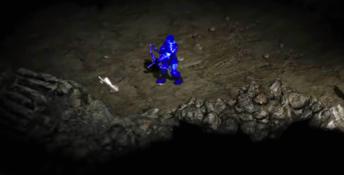
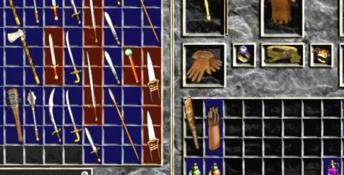
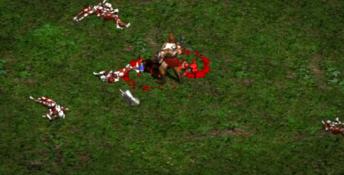
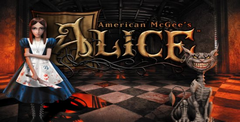 American McGee's Alice
American McGee's Alice
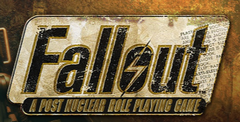 Fallout
Fallout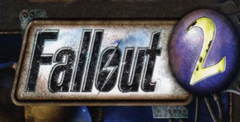 Fallout 2
Fallout 2 Heroes of The Storm
Heroes of The Storm